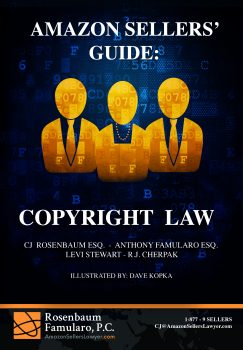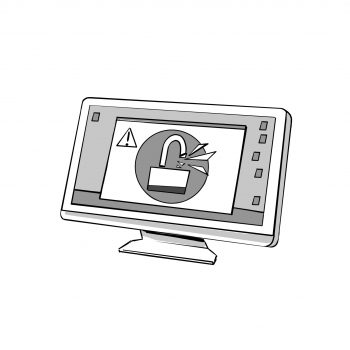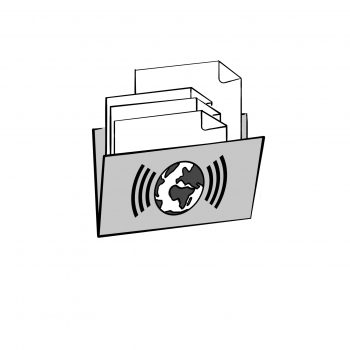
Amazon Sellers’ Guide: Copyright Law
By: CJ Rosenbaum Esq., Anthony Famularo Esq., Levi Stewart, and RJ Cherpak
Chapter 3: Digital Marketing Copyright Act & Online Copyright Issues in General ……….. 36
I. History of the DMCA Enactment ……….. 36
II. Purpose of the DMCA ……….. 37
III. Online Copyright Infringement & Liability Limitation Act ……….. 39
IV. Impact of DMCA ……….. 49
Copyright Law: Chapter 3: Digital Millennium Copyright Act
I. History of DMCA Enactment
In 1992, President Bill Clinton implemented an “Information Infrastructure Task Force” in an effort to create a policy to address the emergence of the internet and copyright issues. [1]
In order to accomplish this task, Bruce A. Lehman, the former Assistant Secretary of Commerce, U.S. Commissioner of Patents and Trademarks, and an attorney in the computer software field provided assistance. [2] Lehman was a proponent of copyright holders having greater control over digital content. The World Intellectual Property Organization (“WIPO”), an international organization focused on protecting intellectual property, assisted Lehman in his desires for greater legal control over the digital landscape by implementing his ideas. A year later in 1993, the Administrative Working Group on Intellectual Property Rights began its work as part of the task force implemented by President Clinton.
The Working Group released multiple papers recommending changes to copyright laws in order to adapt to new technology and increased internet usage. In 1996, the WIPO copyright treaty mandated some European countries to afford legal protection and legal remedies in order to combat the circumvention of technologies used to protect copyrighted works. In response to these suggestions from the Administrative Working Group on Intellectual Property Rights and the recent mandates introduced by the WIPO copyright treaty, President Clinton signed the Digital Millennium Copyright Act (DMCA) into law on October 28, 1998.
II. Purpose of the DMCA
 As the prior acts, the Digital Millennium Copyright Act was implemented to keep U.S. copyright law up to date with technology, the explosive growth of the internet and the digital age. [3]
As the prior acts, the Digital Millennium Copyright Act was implemented to keep U.S. copyright law up to date with technology, the explosive growth of the internet and the digital age. [3]
The DMCA implemented two 1996 WIPO treaties: the WIPO Copyright Treaty, and the WIPO Performances and Phonograms Treaty. [4]
The DMCA makes it unlawful to spread and produce devices, services, or technology that can circumvent safeguards in place to control access to copyrighted works. [5]
The Act makes it unlawful to bypass the safeguards that control access to copyrighted works regardless of whether copyright infringement occurred. The only circumstances under which these access controls can be circumvented is when encryption research is being conducted, computer security systems are being tested, or when product interoperability is being evaluated. In certain situations, specific groups such as academic institutions, archives, and non-profit libraries are exempt from anti-circumvention provisions.
The DMCA shields online service providers, like Amazon, from copyright infringement liability as long as the provider satisfies certain statutory requirements and “take down” methods.
The definition of an online service provider is “an entity offering the transmission, routing, or providing of connections for digital online communications.” [6]
The DMCA is made up of 5 different titles; Title II: The Online Copyright Infringement Limitation Act, pertains to the Amazon Seller.
III. Online Copyright Infringement Liability & Limitation Act
Title II of the DMCA adds section 512 to the Copyright Act with the purpose of creating limitations on copyright infringement liability for online service providers, which are known as “safe harbors.” [7] This section of the DMCA implements four specific categories of conduct where platforms like Amazon and other service providers are protected.
The categories include:
· “transitory digital network communications,”
· “system caching,”
· “information residing on systems of networks at the direction of users,” and;
· “information location tools.” [8]
With regard to the first safe harbor “transitory digital network communications,” the definition of “service provider” in section 512(k)(1)(A) is “an entity offering the transmission, routing, or providing of connections for digital online communications, between or among points specified by a user, of material of the user’s choosing, without modification to the content of the material as sent or received.” [9]
As for the other three safe harbors, “service provider” is defined by a broader standard in section 512(k)(1)(A) as “a provider of online services or network access, or the operator of facilities therefor.” [10]
Take Down Policies and Methods
In addition to the creation of each of these four safe harbors, there are two requirements applicable to every online service provider to: (1) implement some type of policy for terminating users who repeatedly infringe, and: (2) that providers need to accommodate and not interfere with the technological safeguards in place to protect copyrighted conduct which are referred to as “standard technical measures” in section 512(i) of the Copyright Act. [11]
Section 512(i) Act defines “standard technical measures” as “technical measures that are used by copyright owners to identify or protect copyrighted works and (A) have been developed pursuant to a broad consensus of copyright owners and service providers in an open, fair, voluntary, multi-industry standards process; (B) are available to any person on reasonable and nondiscriminatory terms; and (C) do not impose substantial costs on service providers or substantial burdens on their systems or networks.” [12]
Transitory Digital Network Communications:
Section 512(a) implemented transitory digital network communications as the first of four safe harbors and applies to online service providers engaging in the transmitting and routing of data or messages across the internet at the request of a user. [13]
In addition to covering acts of transmission, routing and providing connections for the information requested, this safe harbor applies to the intermediate and transient storage of material made automatically in the network’s operation. [14]
In order for a provider to receive protection under this safe harbor, they must comply with numerous requirements, including:
(1) the information must be initiated or transmitted by or through the direction of someone who is not the service provider;
(2) the transmission, routing, provision of connections, or storage must be done by an automatic technical process in which the service provider does not select the material;
(3) there must be no selection by the service provider as to who receives the material outside of the automatic response to the person who requested the material;
(4) any intermediate or transient copies cannot be ordinarily accessible to anyone besides anticipated recipients and for a period that is not longer than reasonably necessary, and;
(5) the content of the material cannot be modified as it is transmitted through the network or system. [15]
System Caching:
 Section 512(b) provides limitations on service provider liability when providers retain copies of material that a person other than the provider previously made available and transmitted to a user at their request. [16] Amazon can save content without subjecting itself to liability.
Section 512(b) provides limitations on service provider liability when providers retain copies of material that a person other than the provider previously made available and transmitted to a user at their request. [16] Amazon can save content without subjecting itself to liability.
Under this safe harbor, the provider can keep the material for future requests. This way, when this same material is requested again, the requests can easily be fulfilled by transmitting the copy held onto by the provider instead of having to acquire the material from the original source on the network.
This safe harbor is beneficial because it decreases the bandwidth requirements of the service provider and lowers the waiting time for future requests for the same information. [17]
In order to benefit through the safe harbor on system caching, five conditions must be met:
(1) the retained material’s content cannot be changed,
(2) the provider must adhere to rules about refreshing, reloading, or updating material when requested by the person who makes the material available online when specified in accordance with a generally accepted industry standard data communication protocol,
(3) the provider cannot interfere with the technology that provides “hit” information to the person who posted the material when such technology fulfills specific requirements,
(4) the provider must restrict the access to information to comply with the access restrictions used by the person who posted the material (i.e.: password), and;
(5) the service provider must act swiftly in removing or blocking any material that is posted without the authorization of the copyright owner upon receiving notice that this unauthorized material has been blocked, removed or ordered to be blocked or removed at the originating site. [18]
Information Residing on Systems or Networks at Direction of Users (Sellers):
Section 512(c) provides protection for hosting companies and platforms whose system-hosted websites possess infringing material. This limitation applies to storage based on the user’s request.
However, similar to the first two safe harbors, there are also multiple requirements that must be satisfied to enjoy the benefits of this safe harbor:
(1) the service provider cannot have requisite knowledge that the material or activity utilizing the material is infringing;
(2) in addition to not having actual knowledge, they also must not be aware of facts or circumstances that would make it clear that infringing activity is clearly present;
(3) in the event that the provider were to have actual knowledge, they must act quickly to remove or prohibit access to the material;
(4) in a case where the provider has the ability to control such activity, they are not receiving any financial incentive pertaining to the infringing activity and;
(5) the service provider must act quickly to remove or block material that is the subject of a copyright infringement claim.[19]
CJ’s Tip: The safe harbor provisions are satisfied by Amazon’s and the other platform’s take-down mechanisms. Amazon’s system seems to take down products with no evidence of any infringement. This is great for rights owners and awful for legitimate Amazon Sellers who sell grey market goods. eBay uses the Vero[20] system which requires more from the complainant and AliExpress mimics the Chinese legal system where a complainant must have registered rights in order to assert a complaint.
Information Location Tools:
Section 512(d) limits the liability of providers for their conduct in referring or linking users to a site that contains infringing material by way of information location tools such as an online directory, hyperlinks and search engine. [21] As is the case in the first three safe harbors, there are also multiple requirements that must be met in order to enjoy the benefits of this safe harbor.
These requirements include:
(1A) the service provider must not possess actual knowledge that the material or activity is copyright infringing;
(2A) in the absence of actual knowledge, the service provider cannot have knowledge of facts or circumstances from which it would be apparent that infringing activity was present;
(3A) upon obtaining actual knowledge, the provider must act quickly to discontinue or prohibit access to the copyright infringing material;
(B) the service provider cannot receive any financial compensation directly related to the infringing material in a case in which the provider has the option to control such activity, and;
(C) upon obtaining actual knowledge that the online location that the provider referred users to, has infringing material, the provider must also remove or prohibit access to the reference or link that is used to access this infringing material along with any information that is reasonably sufficient to allow the service provider to locate that reference or link. [22]
Special Rules Regarding Liability of Nonprofit Education Institutions:
Section 512(e) governs situations in which a faculty member or graduate student employee is performing research or teaching duties in their capacity as an employee of a public or nonprofit institution of higher education and when their knowledge or conduct impacts a nonprofit educational institution’s eligibility for one of the four safe harbors. [23]
The transitory digital network communications and system caching safe harbors provide that the student or faculty member should be deemed a person other than the provider in order to prevent the institution’s eligibility from being disqualified. With regard to the information residing on systems or networks at the direction of users and the information location tools safe harbors, the faculty member or student’s awareness/knowledge will not be attributed to the institution.
In order for the institution to maintain its eligibility for one of these four safe harbors, multiple conditions must be satisfied.
These conditions are as follows:
(1) the infringing activity of the faculty member or student cannot involve giving online access to course materials that were required or recommended within the past three years for a course that the faculty member or student taught at their institution;
(2) the institution must not have received more than two alerts within the past three years that the faculty member or student was infringing, and;
(3) the institution must give informational materials that inform and encourage compliance with copyright law to all of its users.
VII. Impact of DMCA
The enactment of the DMCA is considered one of the most significant moments in United States copyright law since the introduction of the Copyright Act of 1976. [24] However, the enactment of the DMCA received mixed responses from the public.
Supporters of the DMCA argue that the DMCA implemented necessary modifications to U.S. copyright law in order to adapt to the technological advances of the 21st century. That it closed loopholes for new forms of infringement and protected honest copyright holders.
Those opposed to the DMCA argue that this Act allows copyright owners to unfairly extend the control they have over the use of their works. Critics argue that the DMCA threatens free speech and first amendment rights by overextending the power of copyright holders to control the use of their copyrighted works and that U.S. copyright law prior to the DMCA’s enactment was adequate to deal with the technological advances in our society. [25]
For sellers, since Amazon’s implementation of the DMCA through their policies, there have been an increasing number of seller accounts suspended. Intellectual property complaints, because of the DMCA, have increased exponentially because manufacturers have a simplified legal avenue by which to have smaller Sellers removed from the Amazon platform. Larger companies can kick the “little guys” off the Amazon platform more easily, leaving smaller Sellers with no option other than to appeal to Amazon for reinstatement of their account. Reinstatement often comes down to well organized and well-worded Plan of Action sent to Amazon.
Copyright Law: Chapter 3
[1] History of the DMCA, Digital Millennium Copyright Act (last visited July 27, 2018), https://bcgrouptwo.wordpress.com/about/.
[2] IPPI Board of Directors, International Intellectual Property Institute (May 2010), https://iipi.org/2010/05/iipi-board-of-directors/.
[3] Executive Summary, supra note 32.
[4] U.S. Copyright Office, supra note 31
[5] R. Elizabeth & C. Kitchen, Understanding the Digital Millennium Copyright Act, Bright Hub (last updated Jan. 29, 2010), https://www.brighthub.com/office/entrepreneurs/articles/62799.aspx.
[6] About the Digital Millennium Copyright Act, Indiana University (last modified May 14, 2018, 11:47:38), https://kb.iu.edu/d/alik.
[7] U.S. Copyright Office, supra note 31.
[8] Id.
[9] Id.
[10] Id.
[11] 17 U.S.C. § 512 (i)(2).
[12] Id.
[13] Id.
[14] U.S. Copyright Office, supra note 31.
[15] 17 U.S.C. § 512(a).
[16] U.S. Copyright Office, supra note 31.
[17] Id.
[18] Id. at 11.
[19] 17 U.S.C. § 512(c)(1).
[20] VeRO: verified rights owner.
[21] Id. at 12.
[22] 17 U.S.C. § 512(d).
[23] Id. at 13.
[24] Mark Heaphy, The Impact of The Digital Millennium Copyright Act, Wiggin & Dana, LLP, http://www.wiggin.com/files/m%20heaphy%20impact%205-5-2003.pdf.
[25]Amazon Intellectual Property Policy, Amazon Seller Central (last visited July 27, 2018), https://sellercentral.amazon.com/gp/help/external/201361070?language=en-US&ref=mpbc_201361050_cont_201361070.
